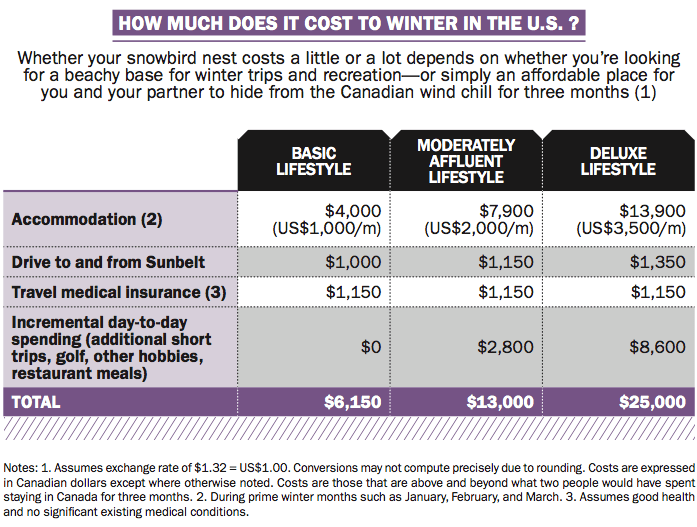Southern exposure
Retirees can still find U.S. sun on any budget, despite the lowly loonie
Advertisement
Retirees can still find U.S. sun on any budget, despite the lowly loonie
 For example, you can find a two-bedroom, two-bathroom “manufactured home” in the community where the Slacks go in central Florida that will run you about US$2,000 a month. The Slacks, who own their unit, love the well-maintained property, which comes with a private golf course, club house and swimming pool.
If you’re looking for more deluxe accommodation, you can spend US$2,500 to US$4,000 ($3,300 to $5,280) a month and get more luxury trappings, such as a two- bedroom condo on the beach or a single-family home similar in size to your nest in Canada. Sherb knows one snowbird couple who spent US$3,500 a month renting a three-bedroom, three-bathroom home with a swimming pool on a golf course in the northwest part of Metro Phoenix. While a home of that size is far beyond the needs of a typical snowbird couple, in this case it provided an attractive spot for family get-togethers involving kids and grandchildren.
At the other end of the spectrum, if you’re trying to enjoy a snowbird lifestyle on a modest budget, you can still find comfortable accommodation on long-term rental for US$1,000 ($1,320) a month or less. In that case, you may need to go for a one-bedroom unit in a less sought-after locale. That’s what Nancy and Gord Hopcraft from Timmins, Ont., spend to rent a one-bedroom condo in Panama City in Northern Florida. (Their unit is on the beach, although at that budget you might have to settle for an inland locale). The Hopcrafts enjoy spectacular sunsets, long strolls on the beach and use Panama City as a base for short trips to places like New Orleans and Savannah, Georgia. Northern Florida is not as warm in winter, but Nancy says she prefers that climate to the high humidity of South Florida.
For example, you can find a two-bedroom, two-bathroom “manufactured home” in the community where the Slacks go in central Florida that will run you about US$2,000 a month. The Slacks, who own their unit, love the well-maintained property, which comes with a private golf course, club house and swimming pool.
If you’re looking for more deluxe accommodation, you can spend US$2,500 to US$4,000 ($3,300 to $5,280) a month and get more luxury trappings, such as a two- bedroom condo on the beach or a single-family home similar in size to your nest in Canada. Sherb knows one snowbird couple who spent US$3,500 a month renting a three-bedroom, three-bathroom home with a swimming pool on a golf course in the northwest part of Metro Phoenix. While a home of that size is far beyond the needs of a typical snowbird couple, in this case it provided an attractive spot for family get-togethers involving kids and grandchildren.
At the other end of the spectrum, if you’re trying to enjoy a snowbird lifestyle on a modest budget, you can still find comfortable accommodation on long-term rental for US$1,000 ($1,320) a month or less. In that case, you may need to go for a one-bedroom unit in a less sought-after locale. That’s what Nancy and Gord Hopcraft from Timmins, Ont., spend to rent a one-bedroom condo in Panama City in Northern Florida. (Their unit is on the beach, although at that budget you might have to settle for an inland locale). The Hopcrafts enjoy spectacular sunsets, long strolls on the beach and use Panama City as a base for short trips to places like New Orleans and Savannah, Georgia. Northern Florida is not as warm in winter, but Nancy says she prefers that climate to the high humidity of South Florida.
Share this article Share on Facebook Share on Twitter Share on Linkedin Share on Reddit Share on Email